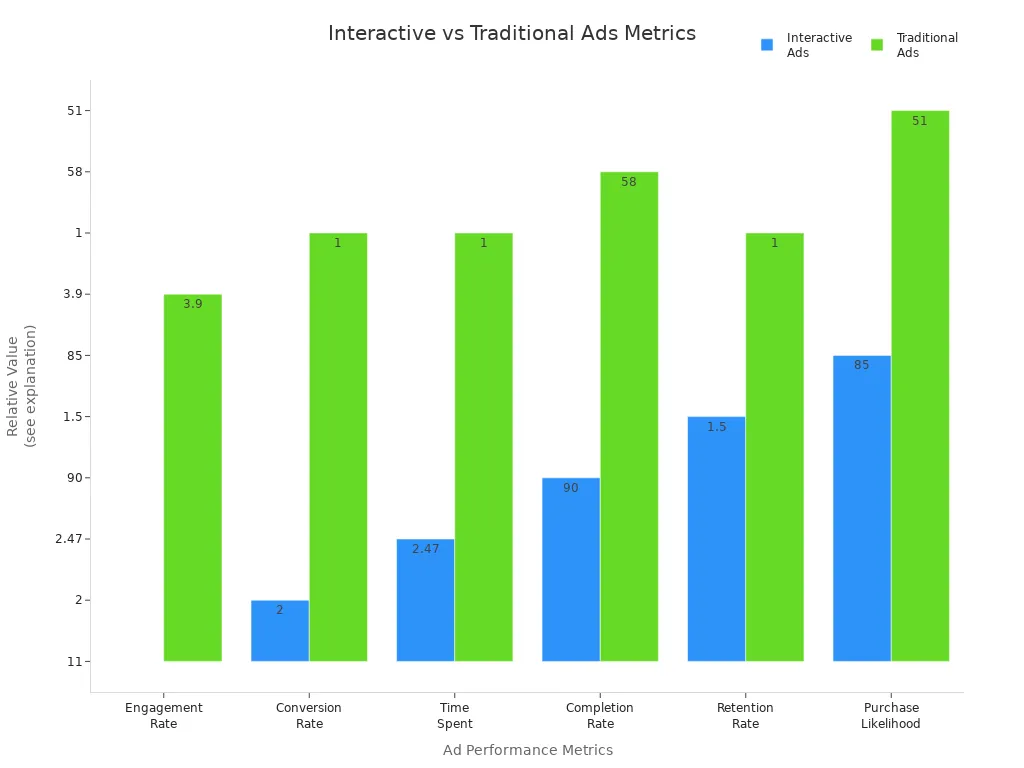
Interactive ad experiences ask users to join in with digital ads by clicking, swiping, or playing. This is different from just watching ads without doing anything. Now, most businesses like digital advertising. About 65% use it to show products. Only 2.7% use only old-fashioned ads. Platforms like TikTok and Instagram help people get more involved, especially Gen Z. People spend 47% more time with interactive ads. This shows that technology is changing how ads work.
Key Takeaways
Interactive ads ask people to click, swipe, or play. This makes ads more fun and interesting than regular ads. These ads use things like AR, VR, quizzes, and games. They help make each ad special and easy to remember. Interactive ads help brands get noticed more. They can help brands sell more and get helpful data. This data helps brands make better ads later. Good design and making ads personal help users use them easily. This also makes the ads work better for each person. Brands use important numbers and tools to see how well ads do. This helps brands fix and improve their interactive ads fast.
Interactive Ad Experiences

Definition
Groups like HubSpot and the Interactive Advertising Bureau (IAB) say interactive ad experiences are digital ads that get people involved. These ads want users to click, swipe, play, or answer questions. They use things like polls, quizzes, games, and interactive videos. This lets brands and users talk to each other. Traditional ads just show information and do not ask for feedback. Interactive advertising is about real-time action and personal connection. The IAB says almost 80% of people like ads that fit their interests. Interactive ads use data to make content personal, which helps build trust and gets more people involved. Interactive videos help brands reach people and get more sales. Interactive ad experiences make ads more lively and focused on the user.
Key Features
Interactive ad experiences use new technology and different formats. Augmented Reality (AR) and Virtual Reality (VR) make ads feel real and exciting. AR puts digital things on top of the real world. VR puts people in a totally virtual place. Brands like IKEA and Sephora use AR so people can try products or see how things look at home. These features help people make good choices and feel sure about them.
Interactive content comes in many types. Some common ones are:
Interactive videos where users pick what happens or look at products.
Polls and quizzes that ask for opinions or test what you know.
Swipeable ads and clickable spots for easy moving around.
360-degree videos that let users look all around.
Note: Interactive content works best when it is simple, easy to use, and good for phones. Brands use gamification to make ads fun and easy to remember. Mini-games and quizzes keep people interested and make them stay longer.
Interactive ads also use progress bars, leaderboards, and rewards to get people to join in. These things make ads fun and make people want to share them. Interactive content can have virtual try-ons, product demos, and online showrooms. These tools help people learn about products and see what they do.
Interactive ads help people remember brands more than regular ads. They also get people to scroll, swipe, or tilt their devices. This active way keeps people interested and helps them remember the ad. Interactive ads often get more people involved, help more people know the brand, and get better results.
Interactive ad experiences have some problems. Brands need to be creative but also make things easy to use. They must make sure ads load fast and work on all devices. Privacy and keeping data safe are important too. Even with these problems, interactive ads help brands stand out and connect with people in new ways.
Interactive content is growing as technology gets better. Brands use interactive videos, AR, VR, and gamified ads to make cool experiences. These tools turn watchers into people who join in. Interactive ad experiences help brands make stronger bonds with people and get better results.
Interactive Ads vs. Traditional Ads
Engagement Differences
Traditional ads just show information. People watch or listen but do not join in. This means people pay less attention and spend less time with the ad. Interactive ads ask users to take part. They want people to click, swipe, play, or answer questions. This makes viewers become participants.
Interactive ads let users make choices or play games. People can give feedback too.
Playable ads, augmented reality, and interactive videos get users more involved. They help people pay attention longer.
Interactive ads match what users like. This makes ads harder to ignore.
Marketers say interactive ads help brands stand out. Almost 93% think they work well for teaching and engaging people.
Traditional ads only send messages one way. They do not let people interact, so fewer people join in.
Interactive ads help brands learn about their audience. When users interact, brands get useful information. They use this data to make better ads next time. Interactive ads focus on the user. They help people remember the ad and stay interested.
User Experience
User experiences are very different with interactive ads and traditional ads. Traditional ads give a one-sided experience. Viewers get messages that do not change. These ads do not respond to what people do. People often ignore them because they do not feel special.
Interactive ads give lively and personal experiences. They use AI and other technology to fit each user’s likes and actions. Real-time engagement makes the ad feel exciting and quick to respond. Users feel important and involved. Interactive ads use quizzes, polls, and games to keep people active. This helps people remember the brand and know it better.
Studies show interactive ads keep users interested longer. Clickable links and navigation bars make people watch ads for more time. Eye-tracking research shows interactive ads get more attention. Brands like Earth Justice and Old Spice use interactive ads to start conversations. These ads help brands connect with people and stand out.
Benefits
Increased Engagement
Interactive advertising makes people join in with ads. This turns viewers into active users. Brands see more people getting involved when they use interactive campaigns. These campaigns ask users to click, play, or answer questions. This leads to better results for brands and more engagement.
The table below shows how interactive ads do better than regular ads:
Statistic Description | Value/Comparison |
|---|---|
Marketers agreeing interactive content engages users better | |
Conversions generated by interactive content vs passive | 2 times more |
Engagement increase of interactive content over static | 52.6% higher |
Engagement of interactive videos vs non-interactive videos | 9 times greater |
Average time spent on interactive content vs static content | 13 minutes vs 8.5 minutes |
Marketers noting interactive videos increase conversions | 35% |
Interactive ads also help more people know about brands. Marketers say these ads help people remember messages and buy more. When people join in, they spend more time with ads. They remember the ads better and feel closer to the brand. AI-powered interactive campaigns can change based on real-world things. This makes ads more useful and gets even more people involved. Studies show these ads can raise ad returns by 25% and brand awareness by 28%.
Data Collection
Interactive advertising lets brands learn from how people use ads. When people join polls, quizzes, or games, brands find out what users like. This helps brands know what people want and how they act.
Common data collected includes:
Poll answers and quiz results
Time spent with the ad
User likes and reactions
How people use products
How happy people are and what they look for
Brands use this information to make better ads next time. They check things like how many people join in, finish, or buy something. Real-time feedback helps brands change ads and make them fit users. Privacy is important, so brands use first-party data and ask for permission. This helps build trust and keeps people coming back.
Interactive Content Formats

Interactive content comes in many types. Each one helps make ads more fun and easy to remember. Marketers use interactive videos, quizzes, polls, games, AR/VR, clickable spots, and interactive audio ads. These formats help brands connect with people. They turn viewers into people who join in. This makes ads work better.
Implementation Complexity | Resource Requirements | Expected Outcomes | Ideal Use Cases | Key Advantages | |
|---|---|---|---|---|---|
Interactive video ads | Moderate to High | High | Immediate transactional engagement | E-commerce, product promotion | Seamless shopping experience within video |
High | High | Extremely high engagement, viral | Extended user interaction | Memorable brand experiences, valuable data | |
Augmented Reality (AR) ads | Very High | Very High | Highly memorable, reduces hesitation | Fashion, beauty, home décor, e-commerce | Strong differentiation, practical utility |
Interactive audio ads | Moderate | Moderate | Higher engagement, brand recall | Podcasts, streaming platforms | Voice-activated responses, hands-free use |
Interactive display banners | Moderate | Moderate | Higher CTR than static banners | Website brand engagement | Cost-efficient, flexible placement |
Gamified Content
Gamified ads use games, quizzes, and challenges to get people involved. These ads work for different learning styles. Visual learners like bright pictures. Kinesthetic learners enjoy playing mini-games. Gamified ads keep people interested for longer. They help brands get noticed. Nike made a mobile game that tracks running and gives discounts. Burger King made a mini-game app that gives special deals. These show how interactive videos and gamified ads turn watchers into active users. Gamified ads also collect helpful data and make people like the brand more. Marketers see more people buying and coming back with these ads.
AR/VR Experiences
AR and VR make interactive content feel real. AR puts digital images on real things. VR creates a whole new world to explore. Brands use these to let people try products or look around. Toyota’s AR campaign let people test drive cars at home. Pizza Hut’s PAC-MAN AR pizza box let people play a game on their phones. These show how interactive videos and AR/VR make ads more fun and easy to remember. This kind of content helps people feel closer to brands and join in more.
Streaming TV uses interactive content too. Amazon’s interactive pause ads let people add items to their cart or learn more with a remote. These ads get more people to visit product pages and buy things than normal ads. Interactive audio ads on podcasts and streaming let people answer with their voice. This makes ads even more interesting. Live interactive ads include webinars and live streams. Viewers can ask questions or vote while watching.
Tip: Marketers should pick interactive content that fits their goals and audience. Using a mix of interactive videos, gamified ads, AR/VR, and interactive audio ads can make ads stand out and get better results.
Strategies
Personalization
Personalization is very important for interactive ad campaigns. Brands use data to make ads fit each user. They split people into groups by interests or past buys. This helps brands send the right message at the best time. Interactive ads can greet users by name or show products they might like. Marketers use reminders if someone leaves a cart. These steps help users feel special and make them want to act.
Ads should match each step of the customer journey.
Landing pages need to look and sound like the ad.
Marketers should test and check results to make ads better.
Splitting users into groups helps brands connect more.
Offers sent at the right time get more people interested.
Surveys say 90% of people like ads made just for them, and 80% are more likely to buy from brands that use personalization.
Technology Use
New technology helps make interactive ads work well. Artificial intelligence (AI) and machine learning help brands learn about users. AI looks at how people use ads, not just who they are. This makes ads more fun and interesting. AI can make many ad versions and pick the best one for each person. AI also helps with gamified ads and AR/VR, making ads more exciting.
AI helps brands show ads to the right people.
Voice and chat AI let users talk to ads in new ways.
Brands using AI often sell more and do better.
User Experience Design
User experience design makes interactive ads easy and fun. Good design keeps things simple for users. Brands should not give too many choices. They should use layouts people know and give clear feedback, like progress bars. Testing helps brands learn what users want. Brands must think about what users need and what they want to achieve.
Use easy ways to move around the ad.
Give users feedback and control.
Test and change designs to fit what people want.
Easy-to-use interactive ads keep people interested and help brands reach their goals.
Measuring Success
Metrics
Brands use different numbers to see how interactive ads do. These numbers help marketers know what users do and how ads work. Some important metrics are:
Impressions: Counts each time someone sees the ad.
Click-Through Rate (CTR): Shows what percent of users click the ad.
Engagement Rate: Tells how many users join in by clicking, sharing, or commenting.
Conversion Rate: Shows what percent of users finish an action, like signing up or buying.
Cost Per Click (CPC): Tells how much each click costs.
Cost Per Acquisition (CPA): Shows the cost to get a new customer.
Return on Ad Spend (ROAS): Tells how much money the ad makes compared to its cost.
Viewability Rate: Shows what percent of ads people really see.
Bounce Rate: Tells how many users leave after clicking.
Completion Rate: Shows how many users finish the ad experience.
Time on Page or Session Duration: Tells how long users stay after clicking.
Interactive ads usually do better than regular ads. For example, interactive video ads make people spend 47% more time than regular video ads. Gamified ads get about 6% higher engagement rates. Click-through rates for interactive ads can be 28.8%. Static ads only get about 3.9%. Interactive ads can also double the conversion rate of static ads.

Tools
Marketers use special tools to check how interactive ads do. These tools help brands see what users do and make ads better fast.
Google Analytics: Tracks what users do and how they use ads.
Facebook Pixel: Follows what users do after seeing Facebook ads and checks conversions.
UTM Parameters: Tags links to show where users come from and how ads do.
Real-time Monitoring Dashboards: Show live numbers so marketers can change ads quickly.
Behavioral Analytics and Attribution Modeling: Help brands see user paths and know which ads work best.
Brands use these tools to watch engagement, conversions, and other key numbers. Real-time analytics let marketers change ads fast. They can stop ads that do not work or spend more on ads that do well. AI and machine learning help guess trends and plan budgets. Custom dashboards give teams the right numbers to make smart choices. These tools help brands get the most from interactive ad campaigns.
Interactive ad experiences let brands talk to people in new ways. They use things like smartphones and streaming to make ads fun. These ads help brands build trust and stand out from others. Brands also get helpful data from interactive ads. Many people do something after seeing these ads. New trends include AR, AI personalization, and immersive content. The table below shows important trends for interactive advertising:
Trend | Benefit |
|---|---|
Augmented Reality (AR) | Immersive product experiences |
AI Personalization | Deeper user engagement |
Omnichannel Campaigns | Stronger brand identity |
Data Privacy Focus | Builds consumer trust |
FAQ
What makes interactive ads different from regular ads?
Interactive ads want users to join in. You can click, swipe, or play. Regular ads just show you things. Interactive ads help people remember brands better. People also spend more time with these ads.
Can interactive ads include shoppable experiences?
Many interactive ads let you buy things right away. Shoppable experiences show items and let you pick what you want. You can finish your purchase without leaving the ad.
Are calculators used in interactive advertising?
Brands use calculators to help people guess costs or savings. These tools make ads more helpful. They help people make smart choices.
How do interactive ads protect user privacy?
Brands collect data from what users do. They follow privacy rules and ask before using your info. This helps build trust and keeps people safe.
What are some popular formats for interactive ads?
Popular formats are quizzes, polls, games, interactive videos, and AR/VR. These formats make ads fun. They help brands connect with people.
See Also
Understanding How Wireless CarPlay Adapters Enhance Driving Experience
Comparing Wireless CarPlay Adapters And AI Boxes For Value
The Impact Of G37 Apple CarPlay Adapters On Driving
Top Wireless CarPlay And Android Auto Adapters Available Now
